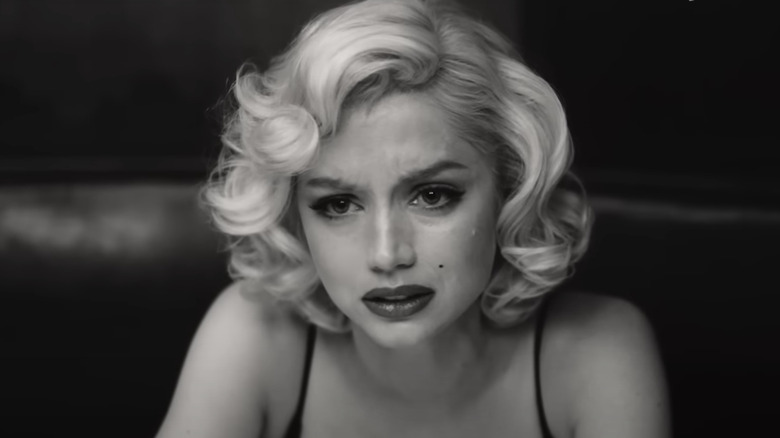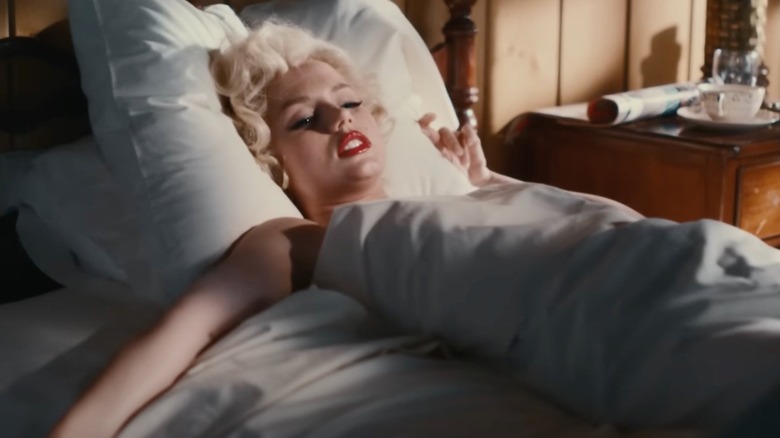Blonde Director Andrew Dominik Kept Ana De Armas From Showing One Specific Emotion As Marilyn Monroe
How did Ana de Armas manage to channel Hollywood's most iconic starlet in "Blonde," Netflix's new movie about Ana de Armas? The actress is known for her roles in a variety of films, from the murder mystery "Knives Out," where she plays characters with a knack for concealment, to a recent Bond girl in "No Time to Die." But Marilyn Monroe may have been her biggest challenge yet. "Blonde" director Andrew Dominik told de Armas to keep one huge feeling totally under wraps for the entirety of the film. This direction guided the actress' performance and informed her understanding of Monroe.
Ana de Armas channeled her own anxiety about living up to the character into her performance. She was scared that people wouldn't accept her portrayal of such a beloved historical figure. "Using my emotions — how I felt about playing the role — was the way I approached the entire film," she revealed to Variety. "Embracing my fears and my vulnerability, my feeling uncomfortable and my insecurities."
These emotions were easy to access for de Armas. Unlike Monroe, who would sometimes stall production for hours at a time while she got into character, de Armas did not take long to channel Monroe. "She'll allow the room to get tense if she needs that space — and in doing that, she puts even more pressure on herself to deliver," Dominik confirmed.
There was one feeling that Dominik insisted that de Armas conceal while playing Marilyn — rage. "He put me in a very, very specific emotional state," de Armas recalled. "Just imagine for a second that you can't express anger. What that does to you is definitely not healthy."
Ana de Armas couldn't express anger as Marilyn
This emotional restriction was very taxing for de Armas on the set of "Blonde." But unlike Marilyn Monroe, de Armas did not embrace a Method approach and instead broke character between takes. "When I'm doing my hair and makeup, it's just me, it's Ana," she explained. This put a necessary separation between her and her character.
Monroe's was a powerful state of mind to enter — one that felt "deeply sad," de Armas admitted. "I felt heavy. I felt helpless that I couldn't change what was happening. I just had to go through a story that I know how it's going to end." An inability to express her frustration compounded this feeling even further. Dominik's direction was like a set of mental handcuffs — the perfect prop for a character in an emotional prison.
Acting is like "having certain kinds of secrets for yourself that you'll let the whole world in on only for a moment," Monroe once told Life Magazine (via The Guardian). She kept her anger a secret until she was fired from Fox in 1962. She was upset with the studio and her fans. "An actor is supposed to be a sensitive instrument," she explained. "Isaac Stern takes good care of his violin. What if everybody jumped on his violin?"
The actress' story serves a haunting cautionary tale of the horrors of fame. Ana de Armas sympathized deeply with Marilyn and grieved for the actress when she finished shooting "Blonde." "I couldn't say goodbye," she recalled. "I went to visit her at her cemetery a few times — I would have liked to go one more time." Ana de Armas' deep understanding of Monroe, aided by Domnik's direction, allowed her to embody the iconic actress in mind, body, and soul.
"Blonde" is currently in limited theaters and will be streaming on Netflix starting on September 28, 2022.

